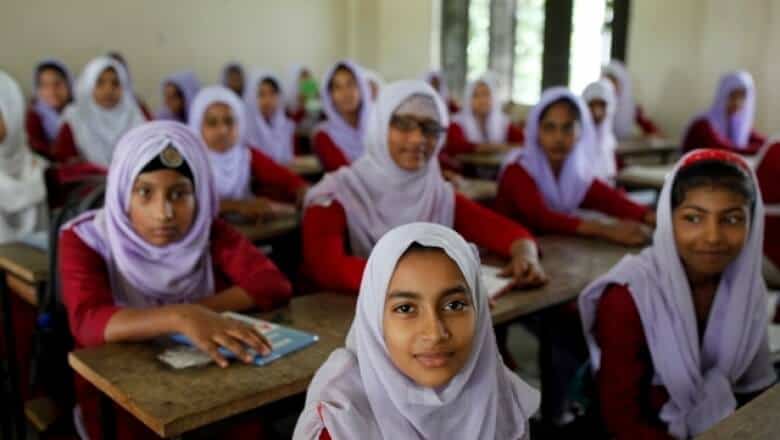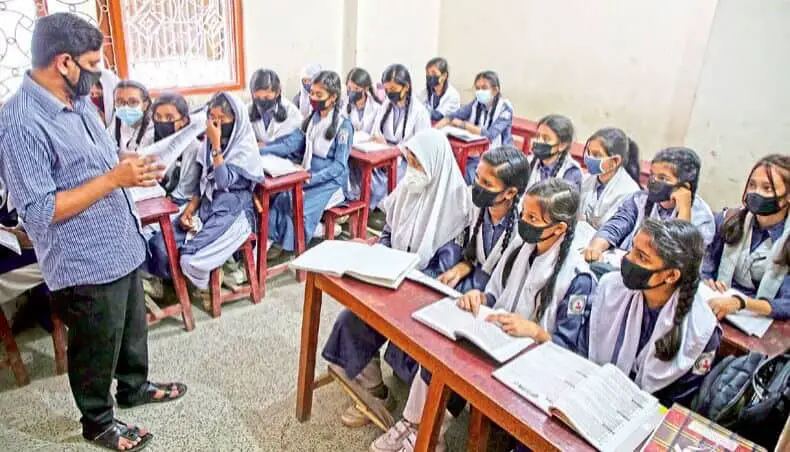Last Updated on May 27, 2023 by Aminul Haque Shahin
The education system in Bangladesh faces several challenges. Firstly, there is a lack of quality infrastructure, including inadequate classrooms, libraries, and laboratories. Secondly, a shortage of trained teachers and a high student-teacher ratio hinder effective learning. Additionally, outdated curricula and teaching methods fail to meet the demands of the modern world. Furthermore, disparities in access to education between urban and rural areas, as well as gender inequality, remain significant issues.
Overview of the education system in Bangladesh
Bangladesh’s education system has seen progress in various aspects since its independence in 1971. The government, along with NGOs and community initiatives, has increased the number of schools and made significant improvements in girls’ participation at all levels of education. However, several challenges remain, including low literacy rates, high dropout rates, poor education quality, and a curriculum that is not aligned with industry needs or focused on essential soft skills.
Despite enjoying free primary education and government-provided textbooks, over 4.3 million children aged 6-15 years are not attending school, and the dropout rates are particularly high in rural areas. The existing curriculum and infrastructure need considerable improvement to create a skilled workforce capable of contributing to the country’s vision of becoming a developed nation by 2041.
Lack of proper school facilities and classrooms
The education system in Bangladesh faces numerous challenges, but the lack of proper school facilities and classrooms remains one of the most significant factors affecting the quality of education for children across the nation.
- Firstly, insufficient infrastructure in urban slums is a critical problem. Children living in these areas are at a higher risk of not attending primary and secondary schools, and when they do attend, there is a higher likelihood of dropping out. Having more schools in these communities must be a priority for the country in order to ensure all children have access to quality education.
- Secondly, outdated facilities at existing schools further hinder the learning process. Many educational institutions lack essential amenities such as separate sanitary facilities for girls, adequate lighting, and proper ventilation. Upgrading these infrastructures is crucial for creating a conducive learning environment for students.
- Third, the quality of education in Bangladesh is often compromised due to a significant number of underqualified teachers. A system for enhanced teacher supervision, monitoring, and accountability should be put in place to ensure educators are equipped with the necessary skills and qualifications.
- Lastly, children with special needs, such as those who are handicapped or from native communities, often have limited access to education. Inclusive policies, resources, and facilities should be developed to accommodate these students, fostering a supportive and diverse learning environment.
Addressing these issues and investing in proper school facilities and classrooms is critical for promoting the development and growth of the education system in Bangladesh.
Insufficient teaching materials and equipment

- One of the major challenges faced by the education system in Bangladesh is the lack of sufficient teaching materials and equipment, especially in technical and vocational institutions. This insufficiency hinders the effective implementation of practical and hands-on learning in technical and vocational courses.
- The problem is further exacerbated by the low availability of multimedia classrooms and underutilized Information and Communication Technology (ICT) systems in many schools. Limited access to the internet and disparities in internet speeds between urban and rural areas also impact online learning in the country. As a result, many students are unable to participate in online classes effectively.
- To address these challenges, it is essential to invest in the procurement and provision of practical equipment and teaching materials for all schools and institutions. Educational policies should also focus on increasing community participation, such as involving parents’ groups and social volunteer groups, in order to enhance the resilience and inclusivity of the education system.
- Furthermore, it is crucial to improve ICT infrastructure and internet connectivity in both urban and rural areas so that all students can access quality online learning. The government, along with international organizations, should collaborate to provide support for teacher training and the development of multimedia content for effective online education in Bangladesh.
Limited access to educational technology
- One major challenge facing the education system in Bangladesh is the limited access to educational technology, especially in rural areas. Internet speed varies widely between urban and rural regions, making online classes difficult for many students (Sohail 2020).
- Additionally, the high cost of internet services and necessary gadgets for participating in online classes puts them out of reach for a significant portion of the population (Khatun 2020). This digital divide exacerbates existing inequalities in educational opportunities, particularly during times of crisis like the COVID-19 pandemic.
- To address this issue, the government and various organizations must work together to develop innovative policies and strategies to reach vulnerable students. This includes expanding ICT infrastructure, offering affordable internet access, and creating government-subsidized devices, facilitating greater participation in online learning.
- Moreover, it is crucial to foster community involvement in education, mobilizing parents, social volunteer groups, and School Management Committees (SMCs) to play a more active role in supporting students during crisis situations (UNDP 2020). By leveraging community resources, the education system in Bangladesh can become more resilient and inclusive, better serving students from diverse backgrounds.
Low quality of teaching and outdated curriculum
Low-Quality Teaching: A major challenge in Bangladesh’s education system is the lack of well-trained, skilled, and motivated teachers. Many educators lack both the knowledge and the tools to teach effectively, as they often resort to rote learning methods rather than engaging students in meaningful learning experiences. To combat this issue, it’s essential to invest in teacher training and professional development programs that emphasize creative, practical, and student-centered teaching methods.
Outdated Curriculum: Another significant problem in Bangladesh’s education system is the outdated and irrelevant curriculum. The current course content does not cater to the needs of a rapidly changing world, leaving students with obsolete knowledge that may not be applicable in today’s job market. To solve this issue, involving education experts and industry professionals in the curriculum development process can help create a more relevant, skill-based curriculum that prepares students for the challenges of the 21st century. This includes updating textbooks, introducing new learning materials, and promoting digital literacy.
Absence of standardized assessments and evaluations
The education system in Bangladesh faces several challenges, one of which is the absence of standardized assessments and evaluations. This limitation hinders the country’s ability to measure and compare students’ academic performance across different regions and institutions.
- Firstly, the lack of a unified evaluation system creates disparities in educational quality. Students in urban areas may have access to better education compared to their rural counterparts, leading to an uneven allocation of resources and opportunities.
- Secondly, without standardized assessments, teachers and administrators are unable to identify areas in which students need additional support. This makes it difficult to implement targeted interventions and improve learning outcomes for all students.
- Thirdly, the absence of standardized evaluations impedes the development of evidence-based educational policies. Policymakers require data on student performance to make informed decisions on resource allocation, teacher training, and curriculum development.
To address these issues, Bangladesh must invest in developing and implementing a nationally recognized assessment system, which includes regular monitoring and evaluation of student performance. This will also involve training teachers to administer these assessments effectively and equitably, as well as investing in the necessary infrastructure to ensure all students are fairly assessed. By prioritizing standardized evaluations, Bangladesh can create a more equitable and effective education system.
Lack of Vocational and Technical Education in Bangladesh
The lack of vocational and technical education in Bangladesh is a significant concern that hampers individual growth, economic development, and overall societal progress. Here are some key points to consider:
- Limited Access: Access to vocational and technical education is limited in Bangladesh, especially in rural areas. Many educational institutions primarily focus on traditional academic streams, leaving a significant portion of the population without access to practical skills-based training.
- Emphasis on Academic Education: The education system in Bangladesh tends to prioritize academic education, often neglecting vocational and technical training. This leads to an imbalance, where a large number of graduates are ill-prepared for the job market, while industries face a shortage of skilled workers.
- Mismatch between Education and Industry Needs: The lack of vocational and technical education exacerbates the gap between the skills possessed by graduates and the requirements of the job market. Industries often struggle to find individuals with the necessary technical expertise, hindering economic growth and productivity.
- Unemployment and Underemployment: The absence of vocational and technical education contributes to high rates of unemployment and underemployment. Many graduates are unable to find suitable jobs due to the lack of practical skills and industry-specific knowledge. This situation leads to wasted human potential and economic stagnation.
- Dependency on Foreign Labor: Bangladesh heavily relies on foreign labor in various sectors, such as construction, manufacturing, and healthcare, due to the shortage of skilled workers domestically. This dependency not only drains the economy through remittance outflows but also limits the opportunities for local individuals to access employment.
- Perception and Stigma: There is a prevalent perception in society that vocational and technical education is inferior to academic education. This stigma discourages individuals from pursuing vocational paths and leads to a shortage of skilled workers in critical sectors.
- Addressing the Issue: To tackle the lack of vocational and technical education, it is essential to prioritize and invest in these fields. This includes establishing specialized vocational training institutes, updating curricula to meet industry demands, and promoting vocational education as a viable and valuable career path.
- Public-Private Partnerships: Collaborations between the government, educational institutions, and the private sector can help bridge the gap between education and industry needs. Such partnerships can provide opportunities for practical training, internships, and job placements, enhancing the employability of vocational graduates.
- Promoting Entrepreneurship: Encouraging entrepreneurship among vocational graduates can create job opportunities, promote self-employment, and contribute to economic growth. Supportive policies, access to funding, and entrepreneurship development programs can nurture a culture of innovation and self-reliance.
Challenges faced by girls in accessing education in Bangladesh
Girls in Bangladesh face several challenges in accessing education. Here are some of the key obstacles:
- Gender Inequality: Deep-rooted gender norms and cultural practices contribute to gender inequality in Bangladesh. Girls often face discriminatory attitudes and limited opportunities compared to boys, leading to unequal access to education.
- Early Marriage and Child Labor: Early marriage is a significant barrier to girls’ education in Bangladesh. Many girls are forced to drop out of school to get married at a young age. Additionally, child labor is prevalent, with girls being engaged in household chores or economic activities, preventing them from attending school.
- Socioeconomic Factors: Poverty is a major challenge affecting girls’ education. Families with limited resources often prioritize boys’ education over girls’ due to cultural and economic factors. Lack of financial means, including school fees, uniforms, and transportation, can impede girls’ access to education.
- Distance and Safety: Accessibility and safety issues also affect girls’ education. In rural areas, schools may be located far from their homes, making it difficult for girls to travel long distances, especially without adequate transportation. Concerns about safety on the way to school or at school can also discourage parents from sending their daughters to school.
- Lack of Sanitation and Hygiene Facilities: The absence of gender-segregated toilets and proper menstrual hygiene facilities in schools poses challenges for girls. The lack of privacy and sanitary facilities can lead to embarrassment, discomfort, and absenteeism during menstruation, negatively impacting their education.
- Cultural and Social Norms: Traditional beliefs and norms that prioritize domestic responsibilities for girls can limit their educational opportunities. Social expectations and pressures to conform to gender roles may discourage families from investing in girls’ education or pursuing higher education for them.
- Quality of Education: Inadequate infrastructure, insufficient teaching resources, and a lack of qualified teachers can affect the quality of education available to girls. Poorly equipped schools and low-quality education may further discourage girls from pursuing their studies.
- Limited Role Models: The scarcity of female role models in education and leadership positions can affect girls’ aspirations and confidence in pursuing education. The absence of inspiring female figures can reinforce societal stereotypes and make it harder for girls to envision themselves in non-traditional roles.
References:
https://borgenproject.org/education-in-bangladesh-problems/
Hello, I’m Aminul Haque Shahin, the founder of BangladeshUS. BangladeshUS is a culmination of my love for my homeland, aiming to be the premier blog in the country. I meticulously curate information on diverse topics, from travel stories to essential guides, ensuring our readers receive accurate and valuable insights about Bangladesh for free. Join us on this exciting journey of exploration and discovery. Thank you for being a part of our community.

